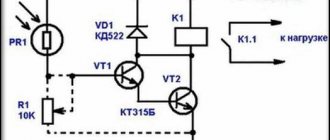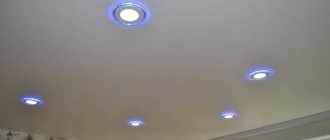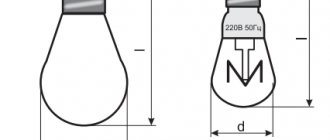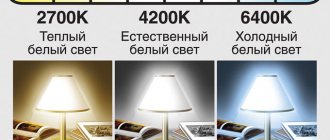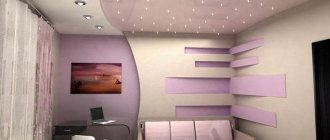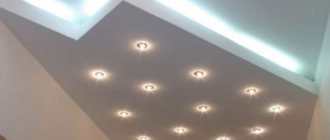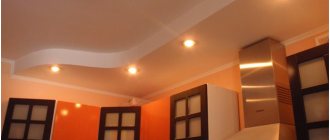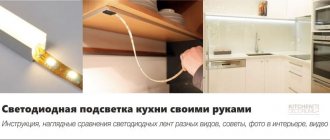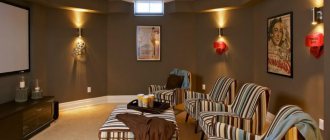Agree, the first lighting device you come across should not be installed in plasterboard structures, suspended ceilings, furniture elements and other objects. We need light bulbs for spotlights located in hard-to-reach and poorly ventilated places. Which type of light bulbs and manufacturer should you prefer?
We will help you make your choice - the article discusses the main types of lamps used for installation in spotlights. Their advantages and disadvantages are given, and useful recommendations are given for choosing the optimal lighting device, taking into account its future location.
We have also selected visual photographic materials and video tips that will help you purchase a light source with good performance characteristics and minimal heating. A properly selected device will provide high-quality lighting to the desired areas and comply with fire safety parameters.
CASE TYPE
One of the most important differences between lamps is the type of base - the location and design of the contacts for connecting to the electrical network.
It's no secret that modern spotlights use different sockets (connectors) into which the lamps are installed. The image below shows a table with the main types of lamps used according to the type of their bases:
As you can see, absolutely all of them have compact pin contacts - this is evidenced by the first symbol of their marking “G”. At the same time, the pins themselves can be different, both in location and size, and in shape. Threaded connections are practically not used. All parameters are described in some detail in “GOST IEC 60061-1-2014 Bases and sockets for light sources with gauges for checking interchangeability and safety.”
Calculation of the number of lamps to illuminate a room
There is a simple formula that allows you to calculate the number of lighting fixtures:
N = (S * W) / P, where:
- S – room area;
- W – specific power of light flux (standard, taken from the reference book);
- P – power of 1 lamp.
On ceilings, it is better to install lighting fixtures symmetrically, evenly over the entire area, which will eliminate shading of individual zones. It is important to make indents of 60-80 cm from the walls, more if there is furniture. The dimensions of the lamps are also taken into account - large ones are placed no closer than 1.6-1.8 m to each other.
Diffuser shape
The next important characteristic is the form of dissipation . There are only two main types:
- flat, having one main luminous surface;
- volumetric ones that shine around themselves, more like a flask in shape;
Accordingly, flat lamps provide only a spot of light underneath them, while volumetric lamps illuminate the space around them. Let's look at how light sources with different bases differ and where they are used most often :
GH53
Lamps with a GX53 base are perhaps the most successful solution for installation in built-in spotlights for a suspended or suspended plasterboard ceiling.
They have a small depth - from 15mm, which allows them to be installed even in small spaces. At the same time, they have a large diameter, on average 75mm. Such a lamp is almost entirely on one side - a light-emitting surface, which is very effective in lighting. The large surface diameter also allows this light source to be effectively cooled, making it last longer.
The pin contacts here have thickenings at the edges, thereby allowing the light bulb to be securely fixed in the lamp socket during installation.
Type : flat diffuser
Standard size: Diameter 75mm, depth from 15mm
Application: Lamps with GX53 socket are often used for decorative lighting, but most often, due to their qualities, they are elements of main lighting. A group of such lamps replaces traditional chandeliers, creating more even illumination of the room.
Marking GX53: GX – pin contacts, distance between contact axes 53 mm.
Conclusion
If you want to organize spot lighting in the suspended ceiling in the bathroom, you can take 12-volt LED bulbs with a power supply. They withstand humidity well, and this voltage is safer.
If you are not ready to bother with additional components, take regular 220 V LED light bulbs. To organize spot lighting, you can take soffit-shaped products of the appropriate color temperature.
What else is worth knowing about LED lamps:
- Why do LED lamps burn out quickly?
- How to protect light bulbs from theft in hallways: folk experience
GU10
Initially, this connector was designed for light sources that operate directly from a 220V network, without a step-down transformer, and was used on standard MR16 type halogen lamps. Nowadays, when almost all types of light bulbs are LED and operate directly from the network, the main feature of the GU10 base is the ability to fix a spotlight in the socket.
Type: flat diffuser
Standard size: Diffuser with a diameter of ~50mm, depth from 50mm.
Application: The most common type of lamp previously was MR16, which has survived to this day. It is equally used for basic and decorative lighting of rooms. The ability to fix the lamp in the connector allows it to be used in lamps of various designs, incl. in turning spots, etc.
Marking GU10: GU – pin contacts, distance between pin axes 10 mm.
Advantages and disadvantages of halogen lamps
The selection of accessories for home lighting should be approached with close attention. Before purchasing a particular model, you should carefully evaluate all the pros and cons of halogen lamps.
pros
The advantages of practical choice include:
- Long service life, which is achieved due to the presence of bromine or iodine vapor. When tungsten filaments are heated, metal vapors evaporate, but this feature is not typical for this variety. The metal particles interact with the buffer gas vapor and settle back on the surface of the thread in the form of a compound.
- Increasing the intensity of the luminous flux. The presence of halogens causes the tungsten filament to heat up more.
- Compact lamp sizes. This feature is associated with the use of quartz glass, which can withstand very high temperatures, as well as high pressure in the flask.
- Low cost often determines the buyer's choice.
- A huge assortment of all kinds of shapes, sizes, designs.
Minuses
Despite the abundance of advantages, halogen lamps still have disadvantages:
- Heating the glass flask, which can cause burns (if handled carelessly).
- All types of halogen lamps are very sensitive to voltage changes in the network.
For such light sources, it is quite difficult to install a glow intensity regulator, which increases energy consumption.
The low level of strength should also be considered a disadvantage, since there is always a risk of accidental damage to the lamp in the house.
G9
Bulbs with G9 socket are volumetric, capsule type. Their properties are most comparable to incandescent lamps. They look like a small bulb that shines around itself, which is successfully used in spotlights with volumetric shades, creating interesting lighting effects. The pin base consists of two loops of wire, with a distance of 9 mm between their axes.
Standard size: Bulb diameter 13-18mm, height from 35mm
Type: Volumetric
Application: In spotlights for decorative and accent lighting.
Marking G9: G – pin contacts, distance between contacts 9 mm.
What to look for when choosing?
Ceiling lamps based on LEDs differ according to the following important criteria:
- supply voltage;
- operating current level;
- base power;
- light output efficiency;
- shade (temperature) of the supplied light flux;
- radiation angle;
- shape and size;
- period of degradation.
All these nuances must be taken into account when purchasing. Only they will help you make the right choice and purchase a device that exactly meets all the requirements that the client places on a home lighting system.
The shape of LED lamps is so diverse that finding an element that ideally matches any ceiling lamp configuration is not difficult.
If you ignore any of the above points, the expenditure of financial resources on the purchase will be in vain, and it will not be possible to create the necessary level of coziness and comfort in the living space. LED light bulbs for general household use have an operating power of 3 to 15 watts.
Similar indicators for modules intended for industrial use reach up to 100 W. The emitted light flux demonstrates high intensity and, with minimal electrical costs, allows you to illuminate rooms of any size.
Lamps have from one to several dozen LEDs. This makes it possible to provide diffused or directional light, depending on the individual needs of the client
The efficiency of products is 90% and in this parameter LED products are significantly ahead of any other light sources.
Criterion #1 - Temperature of Light Produced
The luminescence spectrum of all supply sources is divided into three main groups according to color temperature. The first includes elements that produce warm white light ( Warm White ), very similar to the effect of a classic incandescent lamp.
They operate in the temperature range from 2700K to 3200K and are recommended for use in residential areas.
Warm LED lamps for ceiling lamps can create a cozy atmosphere in the room, conducive to comfortable rest and pleasant communication.
The second group includes the spectrum from 3500K to 5000K. This light is called normal or daytime white ( Neutral White ) and visually resembles the hue of the morning sun of good brightness.
It is perceived by the eye as neutral and is excellent for use in technical rooms of a house or apartment, in offices, classrooms and classrooms, production workshops, etc. Experts indicate that neutral lighting helps increase productivity, helps concentrate attention and does not lead to eye fatigue.
Lighting with neutral LED modules emphasizes the sparkling cleanliness of the bathroom and gives sanitary fittings an elegant and bright shine
In the range from 5000K to 7000K there are cool white lamps that produce very bright daylight ( Cool White ). They are practically not used in living rooms.
These modules are mainly used in hospital buildings, laboratories, corridors and technical premises.
Criterion #2 - radiation angle indicator
Such an important parameter as the radiation angle varies from 20 to 360 degrees for lamps from different manufacturers. This means that the LEDs shine brighter in the center, and reduce the illumination level towards the edges of the dispersion angle.
Modules with a wide dispersion spectrum differ from conventional LED lamps in that they have a front matte lens rather than a transparent one, through which the internal arrangement of the product is visible
This principle of operation allows us to ensure high-quality light supply to a specific space, spending significantly less power on the task. If there is a need to increase the useful illuminated area, an additional diffusion lens is built into the lamp.
Criterion #3 - marking of the size range
All manufacturers of LED ceiling products produce lamps of fundamentally different sizes and configurations.
The most common forms are:
- A – corresponds to the type of classic incandescent lamp;
- B – resembles an oval with a blunt end;
- C – looks like a candle flame;
- CA – called a “candle in the wind” and has a pointed edge slightly curved to the side;
- CW – looks like a candle twisted to one side;
- G – represents a traditional ball;
- E – is an elongated ellipse;
- R – equipped with a reflector (reflector);
- BR - has a convex reflective surface and is slightly larger in size than the R-module;
- MR – equipped with a mirror reflector;
- PAR – has a reflector of an unusual parabolic shape;
- T – is made in the form of a tube, on the surface of which working LEDs are located.
It is these ice lamps that are most popular and are most often used for arranging household and home comfortable lighting systems.
Criterion #4 - glow degradation time
A decrease in the intensity of a lamp's glow over time is a natural process caused by clouding of the crystals during prolonged use. Professionals call this degradation. When this happens, the efficiency of the lighting element decreases and the light saturation of the flux is noticeably weakened.
For LED products from well-known brands, the light intensity decreases closer to the end of the declared service life. Unnamed Chinese-made modules are more susceptible to this and may begin to fade at the very beginning of their operation.
G6.35
Light sources with a G.6.35 socket are analogues of the G9 models presented above. The main difference is that the contacts are made in the form of pins, not loops. Initially, the connection and the cartridges themselves for such a base were considered less reliable. Therefore, they were used in lighting devices with 12-24 V halogen bulbs, through a step-down transformer. Now, in the era of LED technologies, they successfully operate at a voltage of 220V.
Standard size : Bulb diameter 13-18mm, height from 40mm
Type: Volumetric lamp, capsule type
Application: In spotlights for decorative and accent lighting.
Marking G6.35: G – pin contacts, 6.35 – distance between the axes of the contacts in mm.
Lamp layout diagrams
Designers offer a number of classic ceiling lighting schemes using LED devices:
- oval;
- rectangular;
- square;
- round with a central element;
- two semicircles;
- in the form of a cross;
- along the perimeter of the room;
- waves;
- an arc with a center.
First you need to draw a layout diagram on paper. The chandelier is hung in the center or in the middle of the work area. These schemes can be combined to create unusual options. In the corridor it is better to mount the lamps in a line or in pairs. For convenience, the kitchen space is zoned in the form of circles, ovals, and arcs. Waves of dotted luminous elements look attractive in the bedroom. The best option for a child’s room is original designs made from lamps. In the bathroom, lights are usually installed around the perimeter and in the center.
With the help of LED lighting devices, you can easily organize the main and additional lighting. It is important to take into account all the parameters in order to buy suitable devices, then they will last a long time and trouble-free.
G4
These are perhaps the smallest of the volumetric lamps that are used in spotlights. Due to their size and focused light, they are effective in decorative lighting.
Like its older brother G6.35, they were originally designed for low voltage 12V or 24V, but now, in the LED version, they are connected directly to 220V.
Standard size: Bulb diameter 8mm, height from 30mm
Type: Volume lamp, capsule type
Application: In miniature decorative lighting fixtures.
Marking G4: G – pin contacts, distance between contacts 4 mm.
GU5.3
The GU 5.3 base is a complete analogue of GU10, used for MR16 type bulbs. Initially, it was designed for low-voltage light sources operating through a step-down transformer - 12V or 24V. But now, with the development of LED technology, all LED light bulbs with a GU 5.3 base are connected directly to a 220V network.
Type: with flat diffuser Standard size: Diffuser with a diameter of ~50mm, depth from 50mm.
Application: The most common type of lamp is MR16, which has survived to this day. It is equally used for basic and decorative lighting of rooms. The ability to fix the lamp in the connector allows it to be used in lamps of various designs, incl. in turning spots, etc.
Marking GU5.3: G – pin contacts, distance between contact axes 5.3 mm.
GU 4
GU4 is a smaller version of GU5.3, the lamp itself is marked MR11, they are a smaller copy of MR16. Due to their size, they have less power, on average two times that of their older brother, and accordingly, they produce less light. Used for decorative lighting in boxes and niches.
Type: flat diffuser
Standard size: Diffuser with a diameter of ~35mm, depth from 37mm.
Application: In decorative lighting of rooms and furniture.
Marking GU4: GU – pin contacts, distance between pins 4 mm.
As you already understand, the once significant differences in the type of base are now not so relevant, due to the advent of LED lamps, which have low energy consumption, do not heat up and are incredibly durable. Perhaps someday, one common standard will be introduced and the number of socles will be significantly reduced.
Now, if you are buying new spotlights, for example, for a suspended ceiling, pay attention to the type of lamp according to the method of illumination, its power, color temperature and luminous flux, and not to the base, it is not so important.
This knowledge will only be useful to you when replacing existing light bulbs if they burn out.
Variety of shades
Incandescent light bulbs can only provide yellow or very warm, milky light. Because of this, its quality and brightness drops significantly.
LED bulbs are capable of displaying an impressive range of colors, from violet to red, white and yellow spectrums. If desired, you can choose a model that will best match the color of incandescent lamps.
Photo: colored LEDs
Before purchasing light bulbs, be sure to check the color range; on the packaging it is presented in Kelvin. The lower the number, the warmer the light. The usual shade of incandescent lamps is between 2700 and 3000 Kelvin. The higher the indicator, the brighter and cooler the light will be.
Harsh colors are hard on the eyes, so we recommend using them either in case of emergency or for installation on billboards or exhibition halls.
